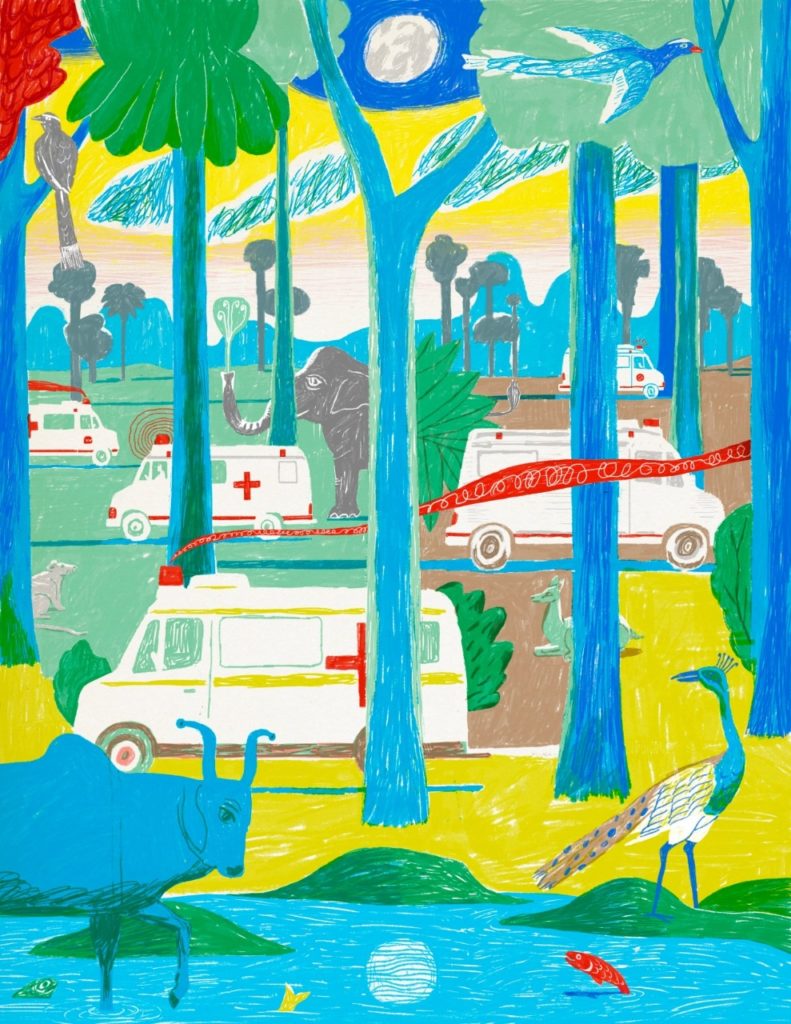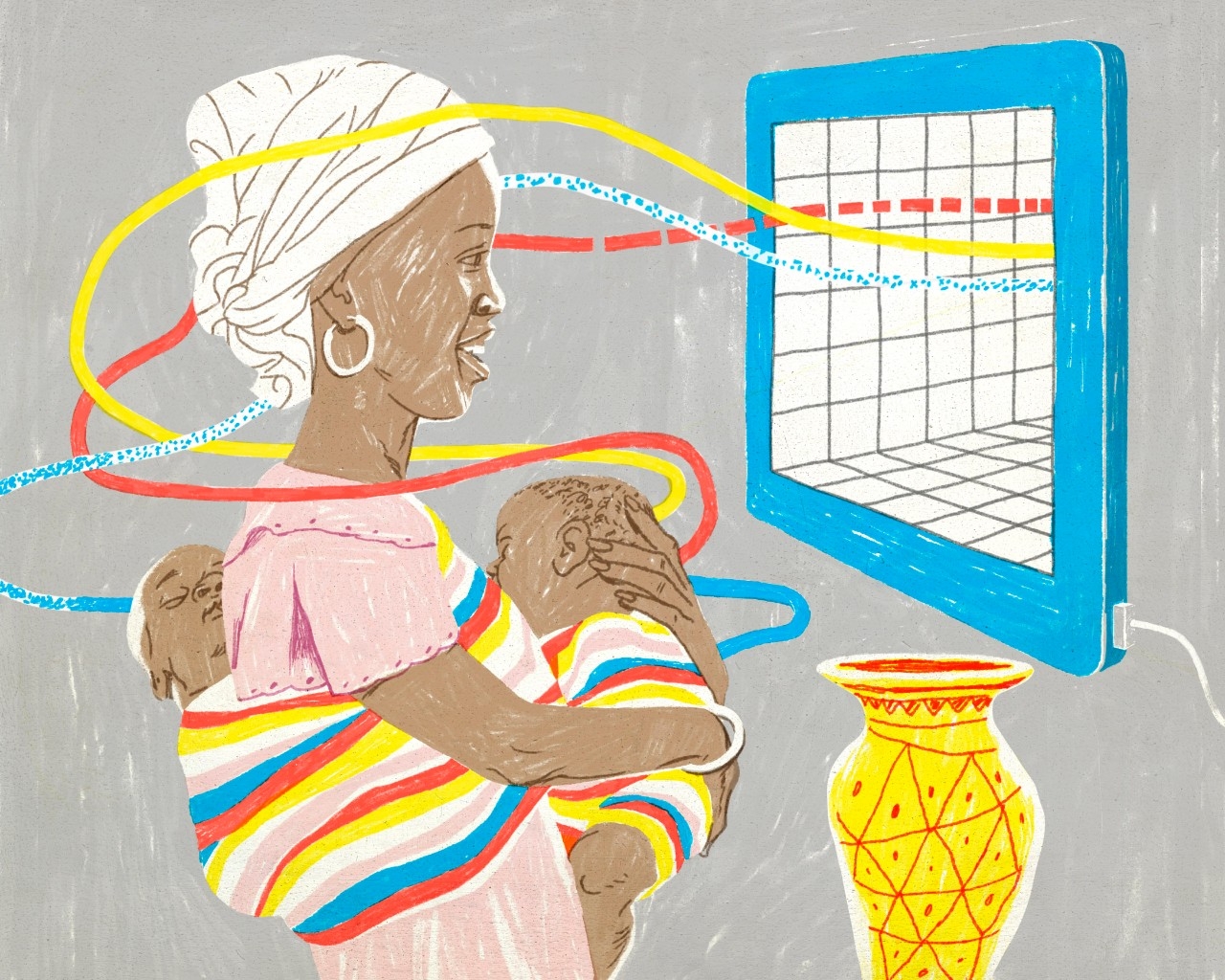A global vision
The high-tech and high-touch goal to impact 2 billion lives by 2025

An ambulance arrives to assist a woman in labor on the outskirts of Kathmandu and the emergency medical technician realizes there are complications he’s not sure how to address. He quickly consults an application on his smartphone that offers guidelines on what to do.
Stanford emergency medical faculty anticipate that such a scene could be happening now, as the nonprofit Nepal Ambulance Service, or NAS, aims to support several dozen health workers who have completed the nation’s first-ever EMT training program, developed by Stanford educators and their Nepali counterparts. Together, they developed the app and are now studying it to see whether it improves the EMTs’ performance.
When NAS began operating in 2011, it was the first and only ambulance service available to the more than 1.3 million people in the Kathmandu area. Since then, it has carried more than 18,000 patients who have called its three-digit toll-free number — 102 — for help.
It is modeled in part on a nonprofit in India, GVK Emergency Management and Research Institute, which has grown to be the world’s largest ambulance system since its founding 13 years ago. In India, more than 750 million people can now access emergency services provided by some 47,000 EMTs, dispatchers, drivers and other workers who staff GVK EMRI’s ambulance system.
Faculty in Stanford’s Department of Emergency Medicine have been involved in both organizations from their beginnings, as well as with initiatives in Cambodia, Myanmar, Uganda and elsewhere. They have collaborated with Indian and Nepali researchers to assess patient needs, to set up referral networks and to improve quality of care. And they have not only authored the standard emergency medicine protocols for these countries, but also helped create a workforce to execute them.
These efforts to improve emergency care are part of an ambitious goal presented in Stanford Medicine’s 2018 strategic plan: Dean Lloyd Minor, MD, and Stanford’s Center for Innovation in Global Health aim to impact 2 billion lives by 2025 through its precision health approach.
“There is a need to have boots on the ground. We want to help globalize the work of educators, researchers and practitioners at Stanford Medicine through strong partnerships with local stakeholders.”
The challenge is how to make Stanford innovations in medical training and research accessible to the entire world. The answer is a combination of “high touch” and “high tech” to deliver new programs that draw on Stanford Medicine’s acumen in providing patient-centered care and its expertise in collecting and analyzing data to devise better treatments.
The high-touch part of the equation involves making personal connections. “There is a need to have boots on the ground,” said Michele Barry, MD, senior associate dean for global health and director of the center. “We want to help globalize the work of educators, researchers and practitioners at Stanford Medicine through strong partnerships with local stakeholders.”
The global health center, which has a network of 170 faculty fellows, tracks more than 1,000 Stanford Medicine projects around the world. Every year it arranges for 50 Stanford physician-scientists to embed in programs overseas, and it provides seed grants to launch four to 10 pilot studies that often become major clinical, education and research endeavors.
The partnership between Stanford Medicine and GVK EMRI offers an example of how the high-tech part can work. In India, GVK EMRI receives an average of about 130,000 calls per day through its 27 call centers, providing demographic and clinical data that can be used for quality assessment of its operation. GVK EMRI and Stanford researchers have conducted more than a dozen relatively small studies — lasting four months at most and involving no more than 2,000 participants — about obstetric emergencies, chest pain, vehicular trauma, and other injuries and illnesses. They are also beginning to examine much larger data sets from hundreds of thousands of calls and to use new computational methods, such as machine and deep learning, to gain deeper insights.
A similar research infrastructure is beginning to emerge in Nepal, where the system also gathers information about its patients through initial intakes and follow-up calls with EMTs. NAS is also using the new app to collect data about the types of situations where EMTs seek additional guidance. (A seed grant from Stanford’s global health center funded the development of the app.) The app replaces hard-copy guidelines that were carried in ambulances but seldom used by EMTs. Now NAS can see if EMTs are looking to the guidelines for help and over time it may be able to pinpoint gaps in their training based on their use of the app.
“We’re training the forefathers and foremothers of a new specialty that didn’t even exist in most of the world just a few decades ago.”
“We’re training the forefathers and foremothers of a new specialty that didn’t even exist in most of the world just a few decades ago,” said S.V. Mahadevan, MD, professor of emergency medicine, who brought Stanford Medicine into these partnerships and has led their training efforts. “The recent development of emergency medical services in low- and middle-income countries is arguably the greatest advance in medical care in the last 25 years because of the number of lives impacted.”
Stanford Medicine’s support in developing EMT capabilities is likely to expand into more countries, bringing it closer to reaching its goal of impacting 2 billion lives. While that number may initially seem impossible to achieve, when you consider other global projects combining touch and tech — particularly one underway in South Africa and another longtime initiative in China — you can see how the bar may not be as high as it first appeared.

Making gains against hepatitis B in China
The Stanford Medicine effort to impact 2 billion lives did not emerge overnight. Samuel So, MD, the Lui Hac Minh Professor of Medicine, for instance, has been pioneering partnerships with local health leaders around the world for decades in the fight against hepatitis B. He was one of only two foreign experts invited to speak in 2004 at China’s National Viral Hepatitis Prevention and Control Conference, and he caused a stir when he submitted his talk’s title: “Why eliminating hepatitis B and liver cancer should be a national priority in China.”
“I was advocating for the government to treat this as the major health crisis it truly is,” said So, who founded the Asian Liver Center at Stanford in 1996 to address the high preponderance of hepatitis B among people of Asian descent.
It was one in a series of bold actions he has taken over the years to raise awareness of hepatitis B, a disease he says kills more people worldwide than either AIDS or malaria. He began combating the disease in the United States and has traveled throughout Asia to promote stronger prevention measures, but much of his effort has been devoted to China, which bears the world’s greatest hepatitis burden.
The hepatitis B virus, or HBV, can be transmitted sexually or through shared needles, though in China its spread is predominantly from an infected mother to her child during birth. The virus cannot be spread through casual contact, shared food or saliva.
People typically carry HBV for decades before it becomes active, causing liver cancer and liver disease. There is no cure, but vaccination can prevent HBV infection and early treatment can substantially reduce its deadly complications.
“If China develops a national program to eliminate hepatitis B as a public health problem, other countries will follow.”
About 10 million people in China will die because of it by 2030 unless access to treatment is improved, according to a 2016 news release from the World Health Organization.
While the problem remains serious, China has made tremendous progress over the past three decades. So, who is a fellow at the global health center, and the Asian Liver Center have helped to turn the tide by demonstrating how to expand vaccination and treatment in a cost-effective manner.
China began pushing for all newborns to be vaccinated against HBV in 1992 and a decade later made the shots free for infants. Still, about 40 percent of youth ages 5 to 19 were not vaccinated. As a result, So’s Stanford team took part in an HBV vaccine pilot project intended to sway the Chinese government to administer catch-up vaccinations for unprotected children. The pilot ran from 2006 to 2008 in Qinghai Province in the remote northwest of the country, vaccinating more than 500,000 children.
“We wanted to influence the government to do this for the whole country,” So explained. Stanford’s center provided education and outreach about the benefits of the vaccine, while the Qinghai government administered the shots.
So wanted to use the results from the pilot study to estimate the cost-effectiveness of a national catch-up program. He reached out to researchers in Stanford’s Department of Management Science and Engineering who determined that vaccinating the estimated 150 million unprotected children nationwide would prevent 8.2 million new infections and 65,000 deaths.
So showed Chinese health ministry officials that such a program would lead to a net cost savings of about $900 million. Although it would cost more than $500 million to launch, it would save $1.4 billion through averting the expenses of treating HBV-related diseases. Shortly thereafter, China’s government changed its policy to have free catch-up vaccinations for school-age children.
Over the past decade, So and colleagues have carried out studies showing that treating the estimated 90 million people living in China with chronic HBV infection would be cost-effective. They have also conducted media campaigns and worked with employers to end the pervasive discrimination in China against people infected with HBV. With support from a seed grant from Stanford’s global health center, they have developed a tool for mobile phones to help physicians make treatment decisions.
And this summer they are conducting a pilot study of a strategy to eliminate transmission from mother to newborn. Some 50,000 newborns still become chronically infected annually from their HBV-positive mothers.
“If China develops a national program to eliminate hepatitis B as a public health problem, other countries will follow,” said So.

Encouraging breastfeeding to prevent infant mortality
On a recent morning in March, Maya Adam, MD, a lecturer at the medical school, ran a focus group near Cape Town, South Africa, to evaluate the effectiveness of videos produced by Stanford’s Digital Medical Education International Collaborative, or Digital MEdIC. Sixteen health promoters, who are called mentor mothers, discussed their experience using beta versions of the videos, which aim to promote breastfeeding. It is part of a campaign the South African government has been waging to encourage nursing to counter the nation’s high rate of infant mortality.
One mentor mother told the group how she had been welcomed into a corrugated iron shack in her township where a baby had recently died. The baby’s aunt, who lived there and was expecting a child, explained that her sister had feared that breast milk alone was insufficient; she had started to feed the baby solid food, along with nursing, when the baby was a few months old; the baby began to have diarrhea and gradually wasted away.
The mentor recounted that she took out her tablet computer, provided by the Stanford program, and showed the aunt a video about infant diarrhea: what causes it, how giving solids too soon can lead to problems and how exclusive breastfeeding for the child’s first six months can prevent it. “This is exactly what happened to my nephew,” the aunt said to her. “I am not going to let that happen to my baby.”
The video, produced for South Africa’s campaign, is a part of the larger Stanford program to globally scale up health education. According to the World Health Organization, there is a shortage of 7.2 million health workers. The need for new models to deliver health education is greatest in places that have limited access to physicians and other health professionals, said Charles Prober, MD, Stanford’s senior associate vice provost for health education, who founded Stanford’s Center for Health Education. “Sharing our expertise requires a new approach to how health care education is developed and delivered.”
“Our goal is to be something like a cross between the Khan Academy for health and Netflix, where people binge-watch the content because it’s so engaging and they want to share it with their friends.”
The center, which includes Digital MEdIC, offers 15 free courses through Stanford Online, the private online education company Coursera and other websites run by nonprofits and government agencies. Among the courses are classes for physicians and medical students on antimicrobial stewardship and placement of an arterial catheter, as well as lessons for the general public on maternal and child health and nutrition. More offerings are in the pipeline.
“We are looking to make Stanford’s health care education content available to anyone, anywhere anytime,” said Prober, who is also a fellow at the global health center.
Adam has spent the past year living in South Africa, working with nonprofits and government agencies to produce videos that support their work. “Our goal is to be something like a cross between the Khan Academy for health and Netflix, where people binge-watch the content because it’s so engaging and they want to share it with their friends,” she said.
Digital MEdIC South Africa launched its 100 Percent Breastfed campaign earlier this year with a two-minute video featuring three South African celebrities who are mothers. Each of them calls breastfeeding “the first choice for feeding my baby.” The campaign also includes a website with 27 videos in English and Xhosa on such breastfeeding topics as how breastfeeding works, its benefits, unsafe practices, and breastfeeding and HIV.
“I don’t think we’re done yet,” said Adam, noting that she anticipates refining the videos further and creating more on new topics, all of which can be used in South Africa and beyond. “We need to have a comprehensive global library of content that is uplifting, empowering and evidence-based.”
Seeing results in Cambodia
Stanford Medicine’s bid to impact 2 billion lives involves leveraging existing projects to launch new ones, and the effort to develop prehospital systems has gone to many other countries beyond India. Stanford Emergency Medicine International, a section in the Department of Emergency Medicine, has drawn on its experience with GVK EMRI to design and support prehospital training courses for Cambodia, the Middle East and Bhutan.
Stanford emergency medicine physicians hope the Nepalese government, which is looking to foster nationwide ambulance service, chooses to support NAS in much the same way that government leaders in India chose to help fund GVK EMRI’s expansion into 15 states and two territories. “In EMRI’s case, government officials became believers after witnessing the positive impact of the nascent EMS system on morbidity and mortality,” according to a paper by several members of Stanford’s emergency medicine faculty.
The lessons are also influencing Cambodia, where Stanford Emergency Medicine International, the government Ministry of Health and the University Research Consortium are being funded by USAID for a five-year project to reduce maternal, infant and child death. Cambodia lacked an organized prehospital system for these cases: Transfers from one facility to another were done on an ad hoc basis; triage was not based on need but rather on first come, first served; and there was no common set of guidelines for emergency care, said Peter Acker, MD, an assistant professor of emergency medicine who has worked on the Cambodia initiative, as well as in Nepal and India.
The project has brought triage and referral systems to 38 hospitals in nine of Cambodia’s 24 provinces, and educated providers about emergency protocols, record-keeping and using ambulances. Acker shared a recent report from one of his colleagues to USAID showing how these factors converged to make a difference in one case. A young woman came in the evening to a small rural hospital after delivering her child at home a few days earlier. “She had retained products of conception” — likely remnants of her placenta — “which was leading to severe postpartum hemorrhage,” he said.
Whereas once she likely would have waited her turn, the staff quickly identified how seriously ill she was. “They were able to begin therapy immediately based on new guidelines,” Acker said. They then used a hotline that had been set up for urgent conversations with staff at larger facilities. Upon learning of the case, a hospital with a blood bank and an operating theater sent an ambulance to pick her up. She arrived with her records and immediately had surgery to remove the material from her uterus.
“She is doing great,” said Acker. “Knowing what was in place before, I think I can say she would have passed away without these changes.”
It’s one more life that Stanford Medicine has touched.

